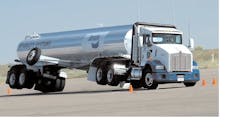With reduced stopping distance rules now complied with and shrinking rapidly as a concern in trucking’s rear view mirror, suppliers are starting to examine ways brake systems for commercial vehicles can be furthered improved – this time with changes to control technology, not to the brake components themselves.
“To meet the new FMVSS-121 reduced stopping distances (RSD), tractor manufacturers required braking systems with higher torque capacity,” Jim Reis, VP/GM for the brake products division at Stemco, explained to Fleet Owner.
For instance, he said most steer axle brakes were upsized from typical 15-in. by 4-in. configuration to larger 16.5-in. by 6-in. configurations, with larger air chambers provided increased brake activation power and more aggressive friction formulations were also employed.
“In many applications, front suspensions were upgraded to manage the increased braking torque and resultant load transfer [with] air disc brakes (ADB) also demonstrating sufficient capability to meet the new regulations,” Reis added.
To use but one OEM example, Peterbilt Motor Co. made ADBs a standard feature on the steer axles of its highway tractors back in 2011 (with its brother company, Kenworth Truck Co., following suit in 2013).
Now, however, brake suppliers are looking to further boost stopping performance by making changes to the brake system control technology as a way to speeding up activation times in order to gain more stopping distance.
“Future foundation brake systems very likely will make use of electronics to assist/control brake activation and improve vehicle balance and stability,” said Stemco’s Reid.
“Hybrid brake-by-wire systems may initially emerge with electronics controlling air reservoirs closely coupled or integrated into the air chambers to decrease the time required to build pressure and activate the brakes,” he added. “Just a 0.5 second improvement in activation time could reduce stopping distance by another 44 feet.”
John Thompson, sales manager at TMD Friction, also believes the focus on a more “electronic braking” architecture will dominate braking system design efforts in the near future.
“Air systems are still required, but the signal to the wheel end is by electronic signal instead of air,” he told Fleet Owner. “This will shave time off the system reaction, between brake pedal movement and brake application. [That means] a vehicle moving at 60 mph or some 88 feet per second will stop eight feet shorter if brake application is reduced by 1/10th of a second.”



